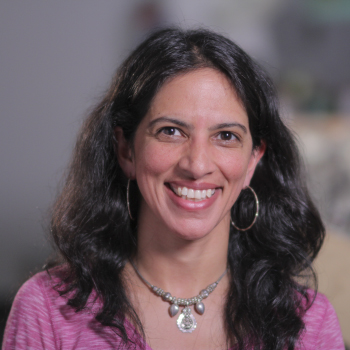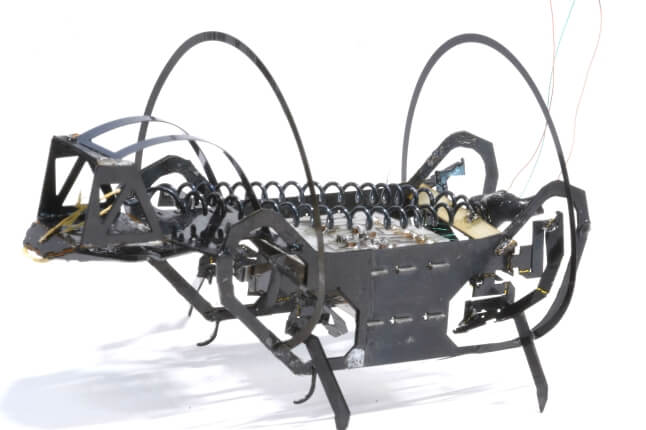News
SLIDESHOW: The Kilobots, Nagpal's swarm of one thousand simple but collaborative robots. The vast scale of this swarm was a milestone in robotics. (Photo courtesy of Mike Rubenstein and Science/AAAS.)
Cambridge/Boston, Mass. – December 18, 2014 – Radhika Nagpal, the Harvard computer scientist whose self-organizing swarm robotics are today’s state of the art in collective artificial intelligence, has been named among Nature’s 10, the ten scientists and engineers who “made a difference” in 2014.
Nagpal is the Fred Kavli Professor of Computer Science at the Harvard School of Engineering and Applied Sciences (SEAS) and a Core Faculty member at the Wyss Institute for Biologically Inspired Engineering at Harvard University.
In February of this year, her research group announced the creation of a robotic construction crew, inspired by termites, which is capable of assembling blocks into 3D structures without any human intervention. And in August, Nagpal’s group unveiled its thousand-robot swarm, a massive assembly of small robots that collectively arrange themselves into shapes, interacting much like a school of fish or a flock of birds. Dubbed “the first thousand-robot flash mob,” these Kilobots demonstrate the power of computationally simple programs to collaboratively and autonomously execute complex behaviors.
“The beauty of biological systems is that they are elegantly simple—and yet, in large numbers, accomplish the seemingly impossible,” Nagpal said. “At some level you no longer even see the individuals; you just see the collective as an entity to itself.”
Nagpal’s research sheds light on the nature of coordination in large groups in order to better understand natural systems like social insect colonies and multicellular self-organization, and to engineer robust and powerful technologies like multi-robot systems for use in search and rescue, construction, or agriculture.

Radhika Nagpal's research group aims to engineer and understand self-organizing, multi-agent systems. This work lies at the intersection of computer science and biology.
“Radhika’s selection as one of the ten most influential scientists and engineers of 2014 is well deserved,” said SEAS Dean Cherry A. Murray, John A. and Elizabeth S. Armstrong Professor of Engineering and Applied Sciences and Professor of Physics. “She looks inside nature’s systems and asks, ‘What makes them tick?’ Biologists, social scientists, and engineers are all paying close attention to her work.”
“It’s tremendous to have Nature recognize the impact that Radhika’s work can have on human lives and the environment,” said Donald Ingber, founding director of the Wyss Institute, also the Judah Folkman Professor of Vascular Biology at Harvard Medical School and Boston Children’s Hospital, and Professor of Bioengineering at Harvard SEAS. “Autonomous swarm robotics could be leveraged to carry out tasks in situations or environments that would be dangerous or challenging for humans, such as cleaning up natural disasters, repairing underwater infrastructures, or building antennas in space.”
Nagpal is in good company. Also recognized by Nature’s 10 this year are:
- Andrea Accomazzo, flight director of the Rosetta mission that landed the first spacecraft on a comet
- Sjors Scheres, for his software that dramatically improves cryo-electron microscopy imagery
- Pete Frates, for turning the ALS Ice Bucket Challenge into the social-media phenomenon of the year, driving awareness and funding for the fight against amyotrophic lateral sclerosis (ALS)
- Sheik Humarr Khan, a scientist on the team that performed the first genetic sequencing of the Ebola virus in the recent West African outbreak, and who remained dedicated to curbing the disease until his death on July 29
- Masayo Takahashi, who led the first surgical transplant derived from induced pluripotent stem (iPS) cells; the retinal transplant could potentially treat age-related macular degeneration
- Kopillil Radhakrishnan, head of the Indian Space Research Organisation, who led India’s Mars mission and who personifies the nation’s huge space ambitions
- David Spergel, who identified problems with the discovery of gravitational waves that were reported to confirm the theory of cosmic inflation
- Maryam Mirzakhani, the mathematician who became the first woman to win the prestigious Fields Medal since the prize’s inception in 1936, for her mathematical findings linking hyperbolic geometry and string theory
- Suzanne Topalian, whose work has been crucial in bringing cancer immunotherapy from the lab to the clinic
“It’s a great honor to find myself among such visionaries,” Nagpal said. “It's really thanks to both the Wyss Institute and SEAS for creating this environment where interdisciplinary research can thrive—and where it's okay to explore wild and crazy ideas that might take many years to click together.”
The ten honorees are profiled in the December 18 issue of Nature.
"Breakthrough" research
"Robots that cooperate," including Nagpal's TERMES robots and Kilobots, were also cited among nine runners-up for Science's 2014 Breakthrough of the Year.
Harvard Robotics
Learn more about robotics research at Harvard in this video.
Topics: Robotics
Cutting-edge science delivered direct to your inbox.
Join the Harvard SEAS mailing list.



